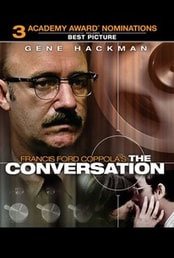| I remember when I first saw “The conversation” fifteen years ago I was not very impressed with the film. At that time I accounted my disappointment to the connection I made with Antonioni’s “Blow Up.” I thought Coppola re-made the same film, but in a sound format, instead of a visual one. “The Conversation” can also be interpreted by Godard’s idea and practice, that in order to criticize a film he makes one. However, I do not think that was Coppola’s intention. Nevertheless, the film made an impression on me, which at that point I did not understand. |
Seeing it again, it made me realize how much I like the film. The slow pace is indicative of the surveillance business of Harry Caul. Just like surveillance, in order for a person to receive the reward of his efforts, patience and observation of the surrounding elements are an essential attribute. The editing, with its repetition of the same shots and elements contributes to the same idea. The idea that we are missing parts of the puzzle and in order to see the whole picture we need to see fragments of it over and over again. The sound design enhances this notion. Sounds are unsettling not only through their repetition, but also by distortion and omission of words and phrases. Walter Murch also mixes sounds that are not present in the frame to evoke the desired feeling with a great success. An interesting example here is the “shock” effect achieved by mixing beat and distorted female scream during the balcony glass partition scene. These modes of uncomfortability are reminiscent of the main character, Harry Caul. He does not feel at ease around people and yet his job is to be blend in crowds. Harry feels at his best when he is alone and playing saxophone along his record player. Yet this desire of his is not granted continuously through the film. His landlord opens his mail and posses a spare keys of his apartment, his telephone is ringing even though he states numerous times that he does not have a home number. And finally he is bugged at the only place he feels comfortable, his castle, but we are going to talk about that a little bit later. In this sense of not achieving his goals, Harry is thematically linked to the homeless person laying on the bench in the first sequence. The identification between the two does not stop there. Coppola links them with the same visual motif - a side view shot of the character laying on a flat surface. Both of them are alone in the world, yet observed by many that are aware of their existence. Harry’s wardrobe also mirrors his isolationist desire. Even though rain is not part of the setting, Harry wears a raincoat. This piece of protective outerwear is more representative of him than his microphones or a saxophone. The raincoat is grey in color, made by a see-through material. The color helps our protagonist to blend in with the surrounding environment. The transparency is indicative of the vulnerability of Harry’s desires. He even wears the coat when he is in bed with his girlfriend Amy. The only time Harry takes his raincoat off, outside his apartment, is when he is having a one night stand with Meredith. And as we know, that is when he gets “robbed.” During this brief encounter, Harry looses his most valuable possession, the fruit of his unprecedented talent, the tapes. The raincoat is another visual element that Coppola uses to show the real substance of the character, his futile privacy desires and his inability to stay anonymous. The device that counters these elements is the music. The smooth jazz score, either diegetic or not, is the perfect compliment for the solemn two hour experience. The reflective nature and the evening quality of the music brings you in and tells you - “relax and enjoy.” The jazz music brings us to the conclusion of the plot, through the cinematography choices. The shots inside Harry’s apartment are static, underlined with their mechanical pans. This hint for solving the mystery at the end of the film is brought to crowning conclusion with the last shot. Perched close to the ceiling, the camera pans back and forth few times in mechanical and dispassionate manner, reminiscent of “fly on the wall.” Harry does not find the microphone hidden in his apartment, because he is looking for a microphone. But there is no microphone to be found, not in the sense that Harry is expecting to find it. Conditioned by his professional experience, Harry is looking for a bug. His talent as a surveillance specialist is known to his employers and enemies as it turns out. In order for them to outsmart him, his employers are exploiting this human trait. Harry does not find the microphone, because the microphone is a surveillance camera.
4 / 5
Director: Francis Ford Coppola
Staring: Gene Hackman, John Cazale, Harrison Ford, Cindy Williams
4 / 5
Director: Francis Ford Coppola
Staring: Gene Hackman, John Cazale, Harrison Ford, Cindy Williams

 RSS Feed
RSS Feed